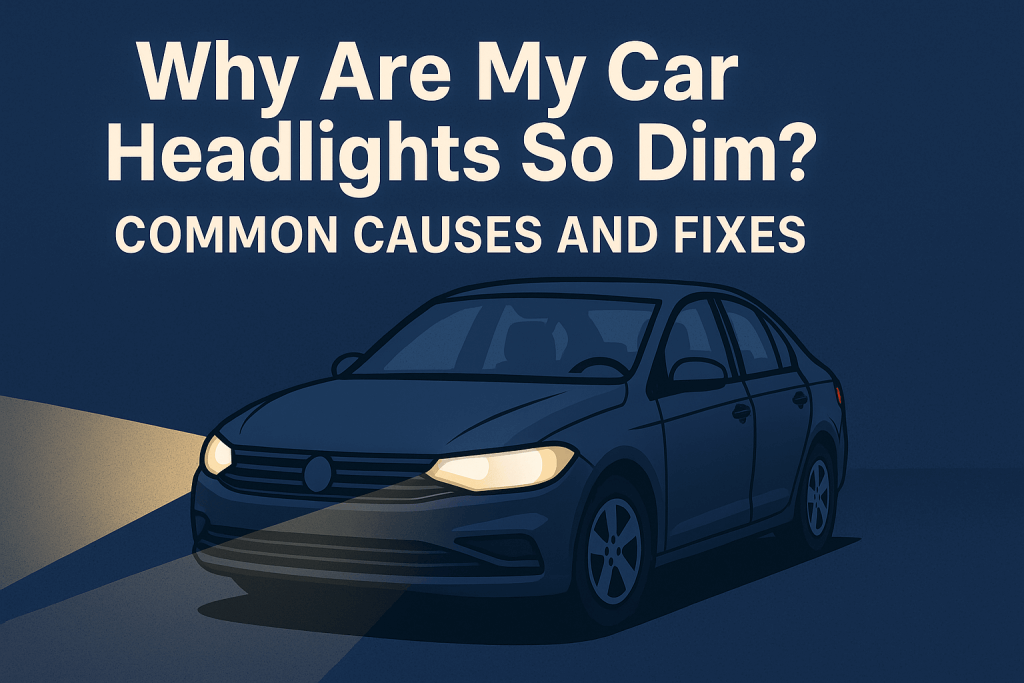Driving at night can already be pretty stressful, especially on unfamiliar roads or in bad weather, but it’s way worse when your headlights seem too dim to properly light up what’s ahead of you. Dim headlights make it really hard to spot hazards like potholes, debris, or animals crossing the road, they reduce your reaction time when unexpected things happen, and honestly, they put you at serious risk of getting into an accident.
Plus, there’s another worry that’s probably on your mind if you’re dealing with headlight problems: is it illegal to drive with one headlight in Florida? While the specific laws change from state to state, dim or completely non-functioning headlights can definitely get you pulled over by police, and that can lead to fines, safety violations, or even having your car taken off the road until you fix the problem.
The good news is that there are several pretty common reasons why headlights lose their brightness over time, and most of them can be fixed without too much hassle or expense if you know what to look for.

Dirty or Cloudy Headlight Lenses
One of the most common culprits behind dim headlights is actually something you can see just by looking at your car: dirty or cloudy headlight lenses. Over time, road grime, salt, bugs, and general dirt build up on the outside of your headlight covers, blocking some of the light from getting through.
Even worse, plastic headlight lenses suffer from oxidation and UV damage from years of sun exposure, which creates a cloudy, yellowish haze that can dramatically reduce light output. You might be surprised how much dimmer your headlights get when the lenses are cloudy, even if the bulbs themselves are working perfectly.
The good news is that DIY headlight cleaning and restoration kits are available at most auto parts stores and can often restore a lot of brightness for just a few dollars. These kits usually include polishing compounds and clear protective coatings that can make old headlights look almost new again.
If the cloudiness is really severe or the lenses are cracked or damaged, you might need to consider professional restoration services or even complete lens replacement, but cleaning should always be your first step.
Aging or Burned-Out Bulbs
Headlight bulbs don’t just suddenly burn out and stop working – they actually get dimmer gradually over time, even before they completely fail. This happens so slowly that you might not notice it until your headlights are significantly less bright than they should be.
Different types of bulbs have different lifespans too. Traditional halogen bulbs typically last about 500 to 1,000 hours, while HID (high-intensity discharge) lights can last 2,000 hours or more, and LED lights often last even longer. But regardless of the type, all bulbs get dimmer as they age.
Signs that your bulbs might be failing include one headlight noticeably dimmer than the other, flickering lights, or headlights that take a while to reach full brightness when you turn them on. If your car is more than a few years old and you’ve never replaced the headlight bulbs, they’re probably due for replacement.
When choosing replacement bulbs, make sure you get the right type and size for your specific vehicle. Higher-wattage bulbs might seem like a good idea, but they can actually damage your headlight housing or electrical system if they draw more power than your car was designed to handle.
Electrical Issues
Sometimes the problem isn’t with the bulbs or lenses at all, but with the electrical system that powers your headlights. Loose connections, corroded wiring, or blown fuses can all cause your headlights to receive less power than they need to shine at full brightness.
When your headlights aren’t getting enough voltage, they’ll appear dim even if the bulbs are brand new. This is especially common in older vehicles where wiring connections might have loosened over time or where corrosion has built up on electrical contacts.
It’s important to check your wiring harnesses and battery health if you suspect electrical issues. Poor battery health can affect your entire electrical system, including your headlights. Corroded or loose battery terminals are a common cause of voltage drop that affects headlight performance.
If you’re not comfortable working with electrical systems, this is definitely a good time to see a mechanic for proper electrical diagnostics. They have the tools and expertise to safely identify and fix wiring problems that could be causing your dim headlights.
Keep Your Night Vision Clear
Dim headlights are way more than just an inconvenience – they’re a genuine safety hazard that could also get you a ticket, especially if one headlight goes completely out and you’re driving with just one working light. Whether the problem turns out to be grime on your lenses, aging bulbs that need replacement, or electrical troubles that require professional attention, diagnosing the issue quickly helps keep your night drives safe and stress-free.
Remember, while you might be wondering is it illegal to drive with one headlight in Florida or wherever you live, the much bigger concern should be your visibility and your ability to see hazards in time to avoid accidents.
Stay proactive about maintaining your headlights, keep your lights as bright as they should be, and enjoy the peace of mind that comes with having a clear, well-lit view of the road ahead of you.
